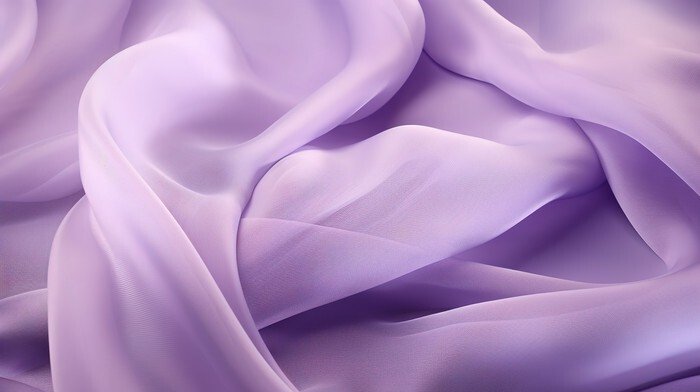Everything you need to know about working with, buying, and caring for chiffon fabric
Table of Contents
- What Is Chiffon Fabric?
- Types and Variations
- Chiffon vs Other Sheer Fabrics
- Properties and Characteristics
- History and Evolution
- How Chiffon Is Made
- Complete Sewing Guide
- Fashion Applications
- Bridal and Special Occasions
- Care and Maintenance
- Sustainability Considerations
- Buying Guide and Prices
- Project Ideas by Skill Level
- Common Problems and Solutions
- Frequently Asked Questions
What Is Chiffon Fabric?
Chiffon is a lightweight, sheer fabric that’s famous for its beautiful drape and delicate appearance. If you’ve ever seen a dress that seems to float as someone walks, there’s a good chance it was made from chiffon. The word comes from the French “chiffe,” meaning cloth or rag, but don’t let that fool you. This fabric is anything but ordinary.
The magic of chiffon lies in its construction. You’ll find it’s woven using a special technique called alternating S-and-Z-twist, where yarns are twisted in opposite directions. This creates a slightly crinkled texture and gives the fabric its signature shimmer and stretch. When you hold chiffon up to light, you’ll notice it’s semi-transparent, allowing about 85% of light to pass through.
Chiffon weighs between 20-50 grams per square meter, making it one of the lightest fabric types available. Despite feeling delicate, quality chiffon has surprising durability thanks to those tightly twisted yarns.
What Type of Fabric Is Chiffon?
Chiffon belongs to the sheer fabric family. It’s a plain-weave textile, which means the threads cross over and under each other in a simple pattern. What makes it special is the high-twist yarns used in the weaving process. These yarns are twisted much tighter than standard yarns, creating that characteristic puckered surface you’ll feel when you touch it.
The fabric can be made from various fibers, both natural and synthetic. This flexibility is why you’ll find chiffon at different price points, from budget-friendly polyester versions to luxury silk options.
What Is Chiffon in English?
In English, chiffon simply refers to this lightweight, sheer, plain-woven fabric. The name was borrowed directly from French and is now used worldwide to describe this specific type of textile. When fashion professionals say “chiffon,” they’re talking about the construction method and appearance, not necessarily the fiber content.
Types and Variations of Chiffon
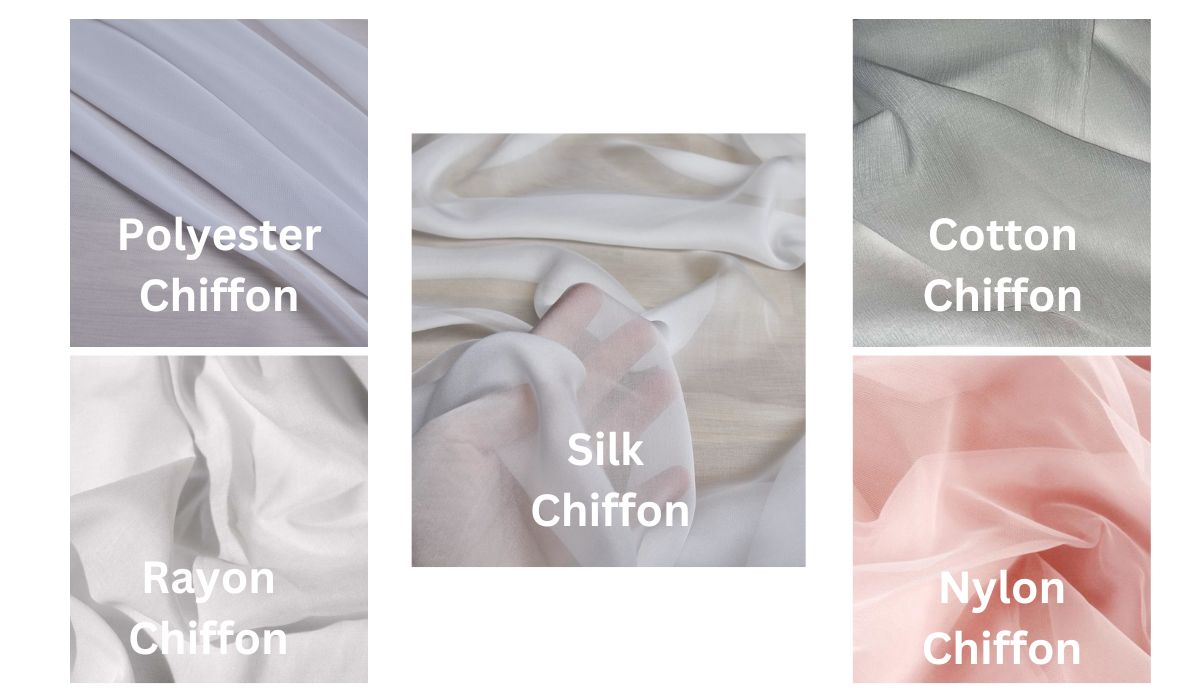
You’ll encounter several types of chiffon, each with unique qualities. Understanding these differences will help you pick the right one for your project.
Silk Chiffon
This is the original and most luxurious type. When you touch silk chiffon, you’ll immediately notice how soft it feels. It has a natural shimmer that synthetic versions struggle to match. Silk chiffon breathes beautifully and feels wonderful against your skin. However, it’s also the most expensive and requires careful handling. You’ll need to dry clean silk chiffon garments to maintain their quality.
$18-$45 per yard
Polyester Chiffon
This is what you’ll find most often in stores. It accounts for over 70% of chiffon production worldwide. Polyester chiffon looks similar to silk but costs much less. It’s more durable, less prone to wrinkling, and easier to care for. You can often machine wash it (carefully), unlike silk which needs dry cleaning. For beginners or practical everyday wear, polyester chiffon is your best choice.
$3-$12 per yard
Is Chiffon Just Polyester?
No, chiffon isn’t just polyester. While polyester chiffon is the most common type you’ll find in stores, chiffon refers to the weaving technique, not the fiber. You can buy chiffon made from silk, cotton, rayon, nylon, or polyester. Each fiber type affects how the fabric feels, drapes, and needs to be cared for.
Is Chiffon 100% Polyester?
Many chiffons are 100% polyester, but not all. Always check the fabric content label. You’ll also find silk chiffon (100% silk), cotton chiffon (100% cotton), rayon chiffon, or blends. The fiber content dramatically affects price, feel, care requirements, and durability.
Cotton Chiffon
Less common but worth knowing about, cotton chiffon is more opaque than silk or polyester versions. It breathes exceptionally well, making it perfect for hot weather. You’ll find it’s machine washable and gets softer with each wash. It’s also a more eco-friendly choice since cotton is biodegradable. Cotton chiffon combines the flow of chiffon with cotton’s natural comfort.
Can Chiffon Be Cotton?
Absolutely! Cotton chiffon exists and offers unique benefits. It’s more breathable than synthetic versions, machine washable, and gentle on sensitive skin. The downside? It’s harder to find and may cost more than polyester but less than silk. Cotton chiffon maintains chiffon’s characteristic flow while adding cotton’s practical benefits.
Rayon Chiffon
This sits between silk and polyester in terms of feel and price. Rayon chiffon has a beautiful drape similar to silk but costs less. It’s softer than polyester and takes dye beautifully, giving you access to vibrant colors. However, it’s not as durable as polyester or silk, and it needs careful handling when wet.
Nylon Chiffon
Nylon chiffon was actually the first synthetic version, invented in 1938. It’s durable, resistant to wrinkles, and strong. However, it doesn’t drape quite as beautifully as polyester or silk. You won’t see nylon chiffon as often today since polyester took over most of the market.
Is Chiffon a Nylon?
Chiffon can be made from nylon, but most chiffon today uses polyester or silk. Nylon chiffon exists but is less common. Remember, chiffon describes how the fabric is woven, not what it’s made from.
Specialty Variations
You’ll also find special types that add unique features:
- Pearl Chiffon: Has an iridescent coating that creates a lustrous, shimmery finish
- Jacquard Chiffon: Features woven patterns directly in the fabric for added texture
- Chameleon Chiffon: Changes color under different lighting conditions
- Stretch Chiffon: Contains elastane fibers for extra flexibility and comfort
- Printed Chiffon: Features patterns dyed onto the surface in endless designs
- Embroidered Chiffon: Has detailed needlework on a sheer base
Chiffon vs Other Sheer Fabrics
People often confuse chiffon with similar sheer fabrics. Here’s how they actually differ:
| Fabric | Texture | Drape | Weight (g/m²) | Best For |
|---|---|---|---|---|
| Chiffon | Slightly rough, flowing | Fluid, body-skimming | 20-50 | Flowing dresses, scarves, blouses |
| Georgette | Crinkled, grainy | Structured with flow | 30-80 | Structured garments, sarees |
| Organza | Stiff, crisp | Structured, holds shape | 40-70 | Ball gowns, overlays |
| Tulle | Mesh-like, net | Holds volume | 15-40 | Tutus, veils, petticoats |
| Voile | Smooth, soft | Gentle drape | 50-90 | Summer blouses, curtains |
What Is the Difference Between Chiffon and Georgette?
This is one of the most common questions. While both are lightweight and sheer, georgette is heavier and has a more crinkled texture. When you run your fingers over georgette, you’ll feel distinct bumps and a grainy surface. Chiffon feels smoother, though still slightly rough.
Georgette holds its shape better, making it better when you want structure in your garment. Chiffon flows more freely and clings gently to the body. For sarees and garments needing defined pleats that stay in place, georgette works better. For romantic, flowing pieces that move with every breeze, choose chiffon.
Price-wise, georgette typically costs slightly more than standard polyester chiffon but less than silk chiffon.
Which Is More Expensive, Chiffon or Georgette?
Georgette usually costs $2-$5 more per yard than comparable chiffon. However, this varies based on fiber content. Silk georgette will cost more than polyester chiffon, while polyester georgette might cost about the same as rayon chiffon. The price difference isn’t huge, so choose based on the look you want, not just cost.
What Is Better, Chiffon or Organza?
Neither is “better” since they serve different purposes. Organza is stiffer and more structured. If you’re making a ball gown with volume or need fabric that stands away from the body, organza is your choice. It’s also less transparent than chiffon despite being sheer.
Choose chiffon when you want fluid movement and soft draping. It’s better for garments that need to flow and move with your body. Organza works for structured designs, while chiffon excels at creating soft, romantic looks. Many wedding dresses combine both fabrics for different effects.
What Is the Difference Between Organza and Chiffon?
The main difference is stiffness. Organza feels crisp and holds its shape, almost like paper. Chiffon feels soft and drapes easily. Organza is perfect for creating volume in skirts or structured elements. Chiffon is perfect for creating flow and movement. Organza also has a matte finish, while chiffon has a subtle sheen.
Properties and Characteristics
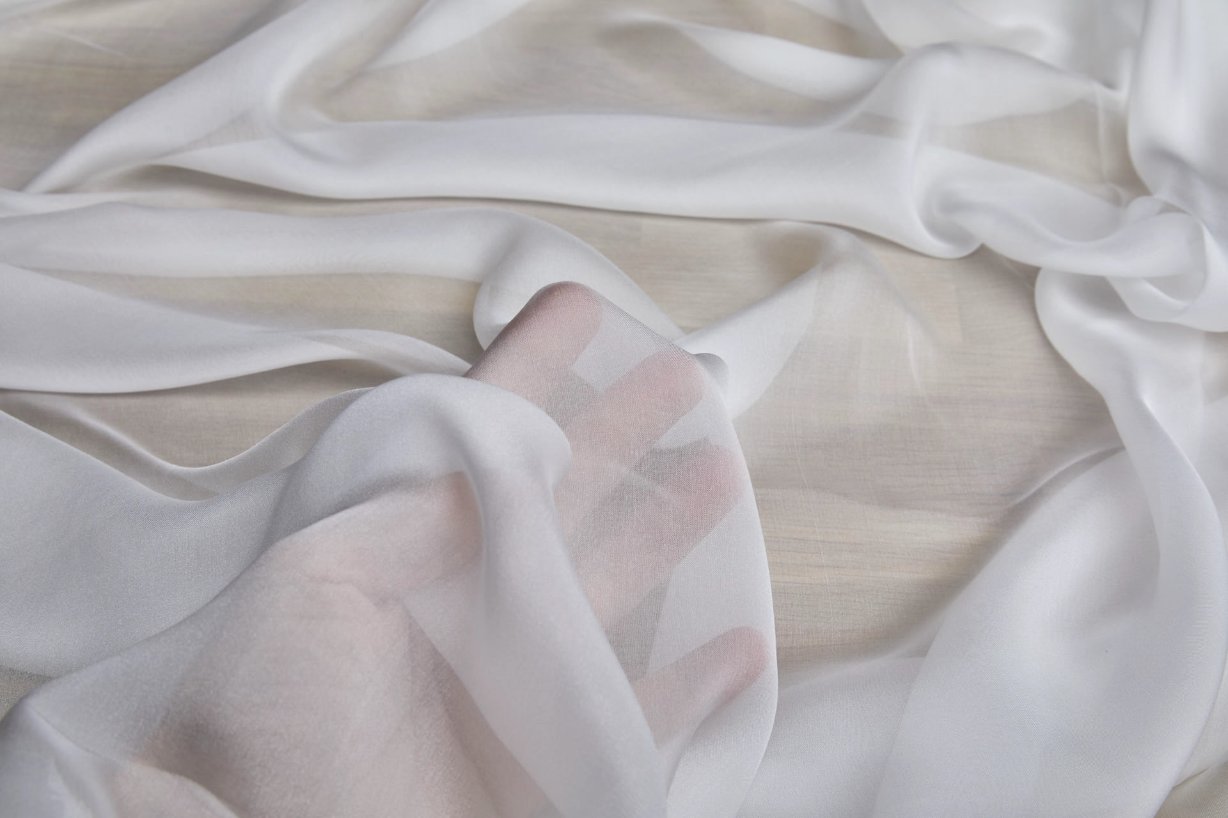
What Does Chiffon Fabric Feel Like?
When you touch chiffon, you’ll notice it has a slightly rough, grainy texture. This surprises many people who expect sheer fabric to feel smooth as glass. The roughness comes from those twisted yarns in the weave. Despite this texture, it feels pleasant against your skin and doesn’t irritate.
The fabric is incredibly light. A gentle breeze can lift it, and when you drape it over your hand, it falls in soft folds rather than hanging straight. This is what designers call “good drape,” and it’s one of chiffon’s most prized qualities.
Is Chiffon Soft or Rough?
Chiffon sits between soft and rough. Silk chiffon leans toward soft, with a pleasant hand feel. Polyester can feel slightly rougher but still comfortable. The texture isn’t harsh or scratchy like burlap. Think of it as having a subtle grain that adds to its character rather than making it unpleasant to touch or wear.
Is Chiffon a Smooth or Rough Material?
Chiffon has a slightly rough, pebbled texture, not smooth like satin. This texture is part of what makes it chiffon. The alternating yarn twists create tiny bumps across the surface. However, “rough” doesn’t mean uncomfortable. It’s smooth enough to wear directly against skin without irritation.
Key Properties at a Glance
Is Chiffon Stretchy?
Regular chiffon has some natural stretch (about 18-22%) from the twisted yarns, but it’s not stretchy like jersey or spandex. The fabric gives a little when you pull it, which makes it comfortable to wear, but it won’t stretch significantly. If you need more stretch for a fitted garment, look for stretch chiffon that contains elastane.
Does Chiffon Wrinkle Easily?
Good news here! Chiffon is actually quite wrinkle-resistant, especially polyester versions. Silk chiffon may develop some creases if left folded for weeks, but they usually fall out when you hang the garment. This makes chiffon great for travel since you can pack a chiffon dress without worrying too much about wrinkles.
Does Chiffon Fabric Wrinkle Easily?
No, chiffon resists wrinkling better than most fabrics. The loose weave and twisted yarns prevent deep creases from forming. If you do get wrinkles, hang the garment in a steamy bathroom for 10-15 minutes, and they’ll usually disappear. Polyester chiffon is the most wrinkle-resistant, while silk may wrinkle slightly more but still much less than cotton or linen.
Does Chiffon Snag Easily?
Yes, this is one of chiffon’s challenges. The loose weave and delicate fibers mean jewelry, rough surfaces, and even your fingernails can catch and pull threads. Once snagged, the fabric can quickly develop runs or holes. You’ll need to handle chiffon carefully and keep it away from anything with sharp edges, rough walls, or Velcro.
Is Chiffon a Flowy Material?
Absolutely! Flow is one of chiffon’s defining characteristics. The fabric drapes beautifully and moves gracefully with any breeze or body movement. This makes it perfect for skirts, dresses, and anything where you want fluid, romantic movement. The lightweight nature means it almost floats as you walk.
How See Through Is Chiffon?
Very sheer! Chiffon allows about 85% of light to pass through. You’ll almost always need a lining or slip underneath, especially with light colors. Cotton chiffon is slightly less transparent, while silk and polyester are quite see-through. Black and dark colors offer more coverage than pastels or white.
Is Chiffon Fabric Heavy?
No, chiffon is one of the lightest fabrics available, weighing just 20-50 grams per square meter. This lightness is one of its main appeals. Even in multiple layers, chiffon garments feel airy and comfortable. You’ll barely feel like you’re wearing anything, which is perfect for summer clothing.
History and Evolution
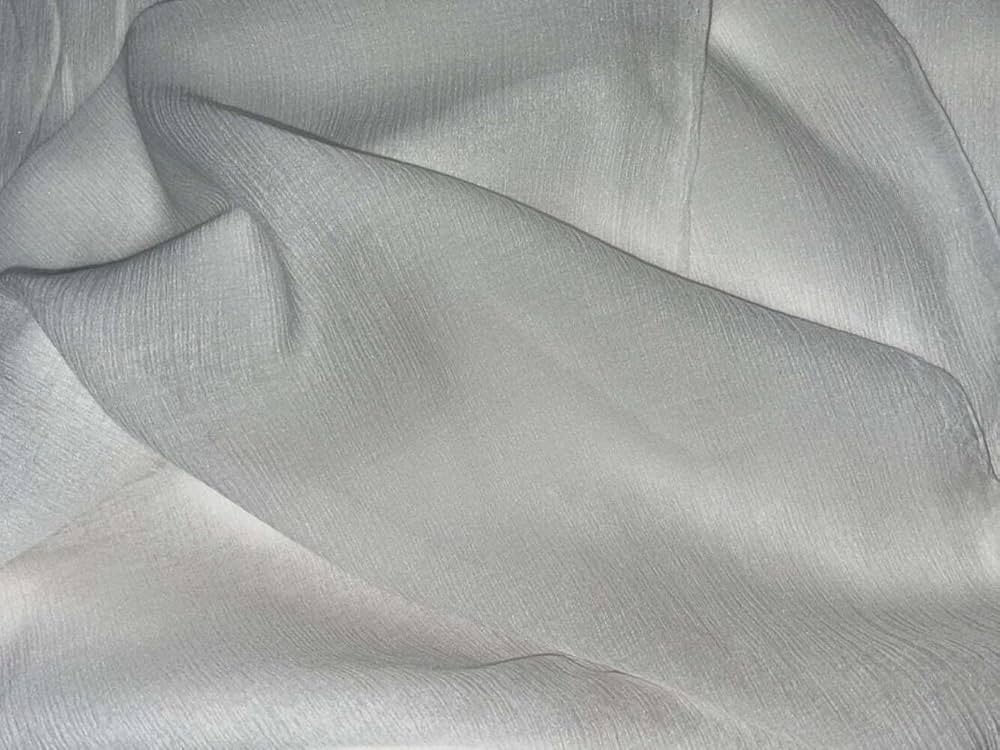
Chiffon’s story starts in France around the 1700s, where skilled weavers in Lyon created it exclusively from silk. At that time, only wealthy aristocrats could afford it. The fabric required 20% more material than standard weaves and took exceptional skill to produce. French noblewomen wore chiffon gowns to show their status and wealth.
The fabric remained expensive and exclusive for over 200 years. Then everything changed in 1938 when chemists developed nylon chiffon. For the first time, this beautiful fabric became accessible to regular people. The synthetic version cost a fraction of silk’s price.
In 1958, polyester chiffon arrived and revolutionized the market even further. Production costs dropped by about 68%, and suddenly, the dreamy, flowing fabric that once symbolized luxury was available to everyone. This democratization of chiffon changed fashion forever.
Today, China produces about 75% of the world’s chiffon supply, with most being polyester. However, French and Italian artisans still craft premium silk versions for luxury fashion houses, preserving traditional techniques passed down through generations. These high-end silk chiffons can sell for ten times the price of polyester versions.
How Chiffon Is Made
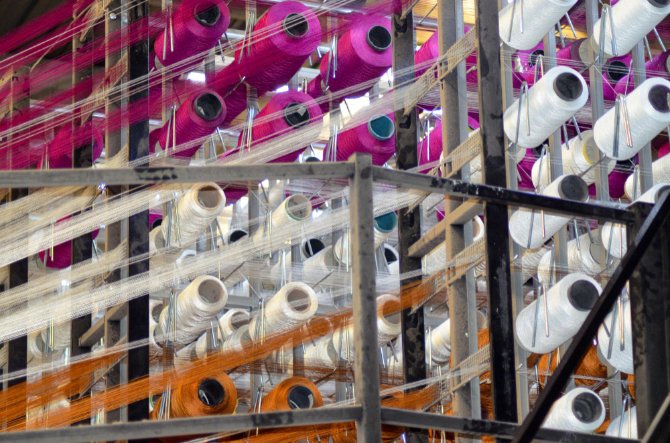
Traditional Silk Production
Creating silk chiffon starts with silkworms. These caterpillars eat mulberry leaves for about 3-8 days, then spin cocoons from silk filaments. Workers soften these cocoons in warm water, then carefully extract filaments that can measure 300-900 meters long. It takes about 20,000 silkworms to produce one kilogram of raw silk.
After extracting the silk, workers twist the fibers using the alternating S-and-Z-twist technique. Some yarns spiral clockwise (S-twist), others counterclockwise (Z-twist). This creates the signature texture. The twisted yarns then go to specialized looms that weave them at 40% slower speeds than standard fabrics to prevent snags and maintain quality.
Modern Synthetic Methods
Polyester chiffon starts as plastic pellets. Manufacturers heat these to 260°C (500°F) and force the melted plastic through tiny holes called spinnerets. This creates thin fibers that are then twisted and textured to mimic silk’s irregular surface.
The process uses specialized air-jet looms that handle the delicate fibers carefully. Quality control teams inspect every 10 meters for consistency, checking that the weave maintains proper tension and the characteristic chiffon texture.
The whole process takes only 3-5 days compared to silk’s 6-8 weeks. This speed and efficiency is why synthetic chiffon costs so much less than silk.
| Method | Materials | Production Time | Cost Per Yard |
|---|---|---|---|
| Traditional Silk | Silkworm filaments, mulberry leaves | 6-8 weeks | $18-$45 |
| Synthetic Polyester | Polyester polymers (petroleum-based) | 3-5 days | $3-$12 |
Complete Sewing Guide for Chiffon
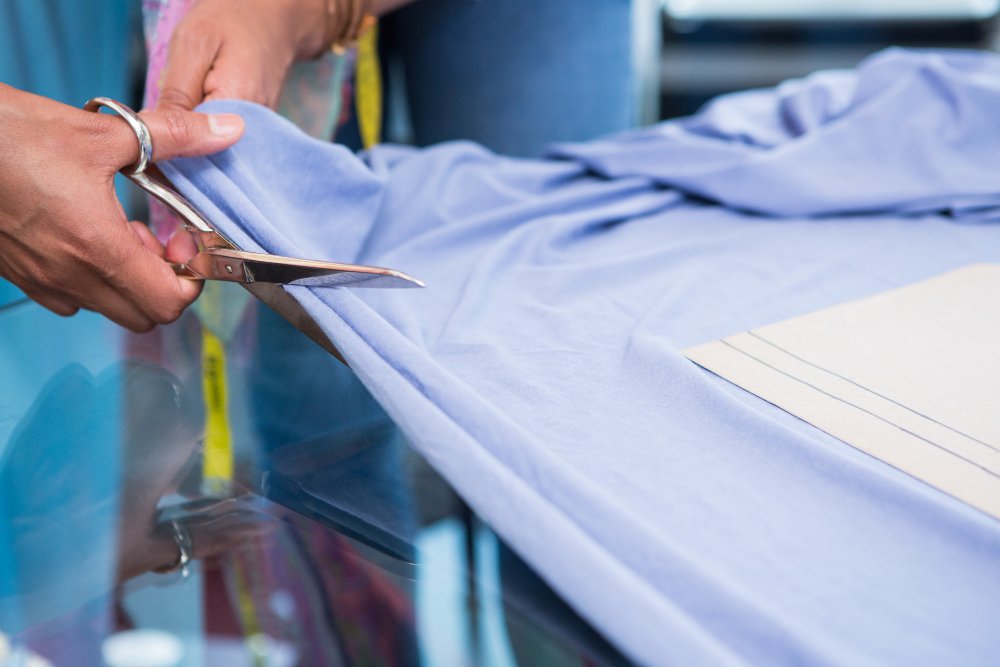
Working with chiffon can feel scary at first, but with the right techniques, you’ll create beautiful results. Here’s everything you need to know.
Before cutting into your good fabric, buy cheap chiffon scraps from your local fabric store. Test all these techniques on practice pieces. This saves you from heartbreak and wasted money later.
Is Chiffon Fabric Difficult to Sew?
Chiffon has challenges like slipping, fraying, and shifting during cutting. However, these challenges are totally manageable once you learn the right techniques. Most sewers find that after making one or two chiffon projects, their confidence grows significantly. The key is using the right tools, not rushing, and accepting that chiffon requires more patience than cotton.
Essential Tools and Supplies
You’ll need specific tools for successful chiffon sewing. Don’t try to make do with what you have. The right tools make a huge difference:
- Needles: Microtex sharp needles, size 60/8 or 70/10. Regular needles will snag the fabric and ruin it.
- Pins: Fine silk pins or better yet, fabric weights. Regular pins leave visible holes that won’t close.
- Thread: Fine cotton or polyester thread that matches your fabric color. Go darker if you can’t find an exact match since lighter thread shows more.
- Scissors: Sharp fabric scissors or a new rotary blade. Dull blades create ragged edges that fray worse.
- Stabilizer: Tissue paper or wash-away stabilizer to prevent shifting during sewing.
- Presser Foot: Walking foot works great, or use the smallest throat plate available for your machine.
- Seam Ripper: A sharp one, though you’ll want to avoid using it since unpicking leaves holes.
Learn more about choosing the right supplies in our essential sewing supplies guide.
Machine Setup
Your sewing machine needs specific settings for chiffon:
- Stitch Length: 12-20 stitches per inch (1.5-2.0 setting on most machines)
- Presser Foot Pressure: Reduce by 30-40% to prevent fabric from pulling and puckering
- Speed: Sew slowly. Fast sewing causes puckering and thread bunching.
- Needle Position: Test on scraps to make sure the fabric doesn’t get pulled into the needle plate
- Tension: Slightly reduce upper thread tension if you see puckering
What Size Sewing Machine Needle for Sheer Fabrics?
Always use size 60/8 or 70/10 Microtex sharp needles for chiffon and other sheer fabrics. These needles have very sharp points that pierce cleanly through the fine weave without snagging or creating large holes. The smaller the number, the finer the needle. For very delicate silk chiffon, use 60/8. For polyester chiffon, 70/10 works well.
What Needle to Use When Sewing Chiffon?
Microtex sharp needles are specifically designed for delicate, tightly woven fabrics like chiffon. Don’t use universal needles, which have a slightly rounded point that will snag. Change your needle every 4-6 hours of sewing or if you notice any skipped stitches. A dull needle will ruin chiffon quickly, creating pulls and runs.
Which Sewing Needle for Chiffon?
The package should say “Microtex” or “Sharp” on it. Schmetz, Organ, and Singer all make good ones. Buy several since you’ll change them frequently. Keep them separate from your regular needles so you don’t accidentally use the wrong one.
Cutting Chiffon Without Tears
Cutting is where many people struggle and give up. Follow these steps carefully:
Cutting Process
Cover your cutting table with tissue paper or use a cutting mat. Smooth surface helps prevent slipping.
Smooth the fabric out completely. Any wrinkles will cause cutting errors. Let it relax for 30 minutes before cutting.
Place pattern weights around the edges instead of pins. Pins distort the fabric and leave holes.
Never cut chiffon on the fold or in multiple layers. The layers will shift, ruining your pieces.
Use freshly sharpened scissors or a new rotary blade. Cut slowly and confidently.
Use tailor’s tacks or thread markers instead of chalk, which may stain or not show up on sheer fabric.
For more on cutting techniques, check our fabric cutting guide.
Can You Just Cut Chiffon?
Yes, but not like regular fabric. You can’t quickly slice through layers. Cutting chiffon requires specific techniques like using tissue paper underneath, cutting single layers, and using weights instead of pins. Rush the cutting, and you’ll end up with wonky pieces that don’t fit together properly.
Will Chiffon Fray When Cut?
Yes, chiffon frays readily and quickly. Raw edges will start unraveling almost immediately after cutting. This is why French seams work so well because they enclose raw edges completely. You need to either finish seams immediately or apply Fray-Check to edges right after cutting.
Can You Cut Chiffon Without It Fraying?
You can’t completely prevent fraying, but you can slow it down. Use a rotary cutter with a new blade for cleaner cuts that fray less than scissors. Apply Fray-Check immediately after cutting (test on scraps first to make sure it doesn’t stain). Work quickly to finish seams before edges have time to unravel significantly.
How to Sew Chiffon Step by Step
Here’s your complete process from start to finish:
- Prepare the Fabric: Sandwich your chiffon between layers of tissue paper. Pin through all layers in the seam allowance only (these holes won’t show).
- Test First: Sew on scrap pieces with tissue paper to check your tension and stitch length. Adjust until seams look smooth.
- Start Sewing: Hold both thread tails as you begin stitching. Pull them gently toward the back to prevent fabric from being sucked into the machine.
- Guide Gently: Let the feed dogs do the work. Guide the fabric lightly without pulling or pushing. Pulling causes stretching and puckering.
- Sew Slowly: Take your time. Speed causes problems. Aim for a steady, slow pace.
- Finish Seams: Use French seams or bind with bias tape. Raw edges fray quickly and need to be enclosed.
- Remove Tissue: Carefully tear away tissue paper after sewing. Work slowly to avoid pulling stitches or ripping the fabric.
- Press Carefully: Use low heat and a pressing cloth, or better yet, steam instead of direct heat.
How to Sew Chiffon Fabric for Beginners?
If you’re new to chiffon, start with these beginner-friendly tips:
- Choose polyester chiffon for your first project since it’s more forgiving than silk
- Pick a simple pattern with straight seams like a scarf or simple skirt
- Buy extra fabric (30% more) to account for mistakes
- Watch video tutorials before starting so you can see the techniques in action
- Set aside extra time and don’t rush
- Accept that your first attempt might not be perfect, and that’s okay
Check out our easy sewing projects for ideas that work well with chiffon.
Can You Sew Chiffon with a Sewing Machine?
Yes, you can and should sew chiffon with a sewing machine. Hand sewing would take forever and create uneven stitches. Your regular sewing machine works fine as long as you adjust the settings correctly, use the right needle, and add stabilizer. You don’t need any special machines.
How to Sew Sheer Fabric on Sewing Machine for Beginners?
The techniques for chiffon work for other sheer fabrics too. Use tissue paper underneath, reduce presser foot pressure, sew slowly, and use fine needles. The key is preventing the fabric from being pulled into the machine and keeping it from shifting as you sew.
What Stitch Is Best for Chiffon Fabric?
Use a straight stitch with 12-20 stitches per inch. This shorter stitch length gives you better control and prevents puckering. Some sewers prefer a very narrow zigzag (width 0.5, length 2.0) because it allows slight stretch, but test this on scraps first since it can create puckering if your tension isn’t perfect.
What Is the Stitch Length for Chiffon Fabric?
Set your stitch length to 1.5-2.0 mm, which equals about 12-20 stitches per inch. This creates small, close stitches that hold the delicate fabric securely without causing puckering. Longer stitches can pull the fabric and create waves along seams.
What Is the Best Stitch Length for Sheer Fabric?
For all sheer fabrics including chiffon, organza, and voile, use 1.5-2.0 mm (12-20 stitches per inch). This universal setting works well for delicate, transparent fabrics. Adjust slightly if you see puckering (go longer) or if seams are weak (go shorter).
What Thread to Use When Sewing Chiffon?
Use fine cotton or polyester thread that’s lighter in weight than standard thread. The thread should be thinner than your fabric or it will create bulk. Match the color as closely as possible, or go slightly darker if you can’t find an exact match. Darker thread blends better than lighter thread which shows more on transparent fabric.
What Thread to Sew Chiffon With?
Fine silk thread works beautifully for silk chiffon, though it’s expensive and can be tricky to work with. For polyester chiffon, use fine polyester thread. Cotton thread works for cotton chiffon. Look for thread labeled “fine” or “extra fine.” Brands like Gutermann, Mettler, and Coats make good quality fine thread.
French Seams: Your Best Friend
French seams are perfect for chiffon because they enclose raw edges completely and look beautiful from both sides. Since chiffon is sheer, you can see the inside of garments, so clean finishing matters. Here’s how to make French seams:
- Place fabric wrong sides together (opposite of normal sewing)
- Sew with 1/4 inch (6mm) seam allowance
- Trim seam allowance down to 1/8 inch (3mm)
- Press seam open, then fold fabric so right sides are together
- Sew again with 1/4 inch seam allowance, enclosing the raw edges inside
- Press to one side
The result is a clean, narrow seam with no raw edges visible. Learn more about French seams in our detailed tutorial.
How to Finish Chiffon Seams?
You have several good options beyond French seams:
- French Seams: Best option for most chiffon garments. Completely encloses raw edges.
- Narrow Zigzag: Use a very narrow zigzag stitch (width 1.0, length 2.0) to overcast edges. Quick but not as neat.
- Bias Binding: Encase seams in lightweight bias tape for a decorative finish. Works well for armholes and necklines.
- Serging: If you have a serger, use it on the finest settings. Serged seams work but can look bulky on very sheer chiffon.
- Hong Kong Finish: Bind raw edges with strips of silk organza or lightweight lining fabric.
How to Hem Chiffon
Hemming chiffon requires patience. You have three main options:
Rolled Hem (Best Option): Use a rolled hem foot on your sewing machine. This creates a tiny, professional-looking hem (about 2mm wide) that’s perfect for chiffon’s delicate nature. The hem foot does most of the work, rolling the fabric edge as you sew.
Narrow Hem: Fold the edge 1/4 inch and press (use low heat!), then fold another 1/4 inch and sew close to the inner fold. This takes time but looks clean. The double fold prevents fraying.
Faced Hem: For circular skirts where regular hems won’t work, use a bias-cut strip of chiffon or lightweight voile to face the hem. Attach the facing strip, then fold it to the inside.
Check out our guide on sewing perfect hems for more techniques.
How to Hem Chiffon Without Sewing for Beginners?
You can use fabric glue designed for delicate fabrics, but this isn’t recommended for anything you plan to wash. The glue can stiffen the fabric and may not hold up over time. For temporary hems on costumes or one-time wear items, use fabric glue sparingly. For anything permanent, bite the bullet and sew it properly.
How to Sew Chiffon Hem with Sewing Machine?
The rolled hem foot is your friend here. Feed the fabric edge into the spiral guide on the foot, and it will automatically roll the edge as you sew. Go slowly and use your left hand to guide the fabric into the foot smoothly. Practice on scraps first since getting the fabric started in the foot can be tricky.
Should You Wash Chiffon Before Sewing?
This depends on the fiber type. Always prewash polyester and cotton chiffon the same way you’ll wash the finished garment. This prevents surprises like shrinking or color bleeding after you’ve spent hours sewing. Silk chiffon shouldn’t be washed before sewing since you’ll dry clean it after the garment is complete. Rayon may shrink significantly, so definitely prewash it.
Common Sewing Problems and Solutions
| Problem | Cause | Solution |
|---|---|---|
| Puckered seams | Pulling fabric, wrong tension, or too much presser foot pressure | Reduce presser foot pressure; use shorter stitches; don’t pull fabric; reduce upper thread tension slightly |
| Fabric eaten by machine | Throat plate hole too large | Use tissue paper underneath; install straight stitch plate; start sewing on a scrap then move to fabric |
| Skipped stitches | Dull or wrong needle | Change to new Microtex sharp needle; check needle is inserted correctly |
| Frayed edges | Natural tendency of loose weave | Use French seams; apply Fray-Check immediately after cutting; finish seams quickly |
| Stretched seams | Pulling while sewing | Let feed dogs do all the work; steam press to shrink back; use stabilizer under seams |
| Fabric shifting during cutting | Not enough stabilization | Use weights not pins; cut through tissue paper; cut single layers only |
If you’re having trouble, check our sewing machine troubleshooting guide for more help.
How to Keep Chiffon Fabric from Fraying
You can’t completely prevent fraying, but you can minimize it:
- Use French seams whenever possible to enclose raw edges
- Apply Fray-Check sparingly on raw edges before cutting (test on scraps first as it can darken fabric)
- Serge or overlock edges immediately after cutting
- Enclose raw edges with bias binding
- Work quickly to finish seams before extensive fraying occurs
- Use a rotary cutter for cleaner cuts that fray less than scissors
How to Stiffen Chiffon for Sewing?
If your chiffon is too floppy to work with, you can temporarily stiffen it with spray starch. Spray lightly, let it dry, then press on low heat. This makes cutting and sewing easier. The starch washes out later. Don’t use this method on silk chiffon. Another option is using fabric stabilizer underneath while you sew, then remove it after.
How to Mend Chiffon Fabric?
Small tears or snags can be repaired, but it’s tricky. For tiny holes, use a fine needle and thread to carefully gather the edges together with tiny stitches. For larger tears, patch from the inside with a small piece of matching chiffon or lightweight iron-on interfacing. Keep in mind that repairs will show on sheer fabric, so prevention is better than fixing.
How to Sew Extremely Delicate Fabric?
For extra delicate fabrics like silk chiffon, take all the regular precautions but add these steps: use tissue paper on both sides of the fabric (sandwich it), reduce thread tension even more, sew even slower, and consider using a shorter stitch length (1.5mm). Handle the fabric as little as possible since oils from your hands can mark it.
How to Tell the Right Side of Chiffon Fabric?
Chiffon often looks identical on both sides, which can be confusing. Look closely at the selvage (finished edge) – the right side usually has a cleaner, smoother selvage. The fabric may also have a very slight sheen on one side. If you can’t tell, just pick one side and mark it with a small piece of tape or safety pin so you stay consistent throughout your project.
Fashion Applications
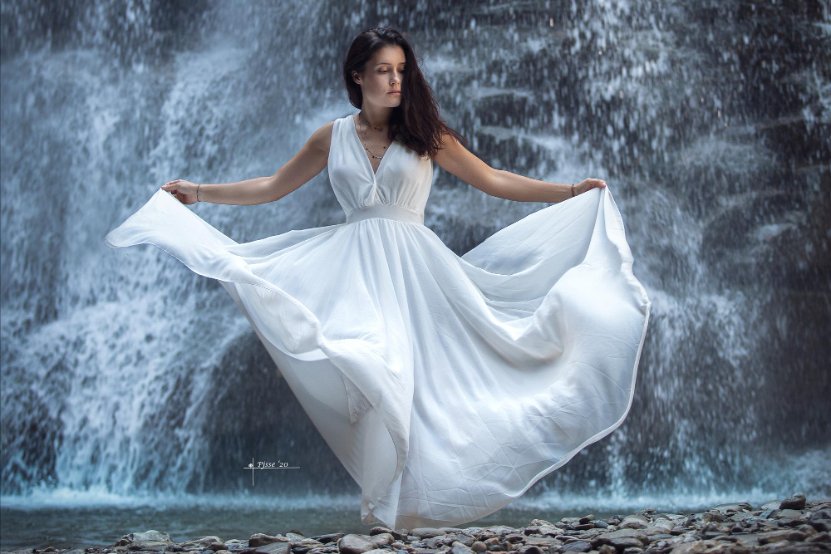
Chiffon works beautifully for many garment types. Here’s where you’ll see it shine and how you can use it.
Evening Wear and Formal Dresses
This is where chiffon really shows off. Designers layer multiple panels to create depth while keeping the garment light. The fabric photographs beautifully under various lighting, which is why you’ll see it on red carpets frequently. Chiffon overlays add romance to cocktail dresses without adding weight or bulk.
For evening wear, you’ll often see chiffon combined with heavier fabrics like satin or taffeta. The chiffon provides flow and movement while the heavier fabric gives structure. This combination creates stunning effects in formal gowns.
Summer Clothing
Chiffon is perfect for hot weather. It breathes exceptionally well, allowing air to circulate freely around your body. You’ll stay cooler in a chiffon blouse than in many heavier fabrics. The light weight means you barely feel like you’re wearing anything. This makes it hugely popular for summer fashion.
Is Chiffon Good for Hot Weather?
Absolutely! Chiffon is one of the best fabrics for warm weather. Its loose weave allows excellent airflow, and its light weight keeps you comfortable. Cotton and silk chiffon work particularly well in heat since they’re natural fibers that breathe even better than polyester. The sheer quality also means you’re not trapping heat against your body.
Is Chiffon Good for Summer?
Yes, chiffon is excellent for summer. The fabric keeps you cool, looks elegant, and doesn’t cling to sweaty skin like some synthetics. It’s perfect for beach cover-ups, summer dresses, lightweight scarves, and breezy blouses. Just remember to use sun protection underneath since the sheer fabric won’t block UV rays effectively.
Blouses and Tops
Chiffon blouses can dress up jeans for a night out or pair with dress pants for the office. Because it’s sheer, you’ll typically need a camisole underneath. The flowing sleeves add elegance to any outfit without looking stuffy. Chiffon blouses are wardrobe staples because they work for so many occasions.
Scarves and Accessories
Lightweight chiffon scarves drape beautifully around your neck without feeling heavy or bulky. They add a pop of color and movement to outfits. You can also use chiffon for hair accessories since the fabric won’t damage hair like rougher textiles. Chiffon also works for decorative elements like bows and trim.
Cultural Garments
Chiffon is hugely popular for sarees and dupattas in South Asian fashion. The fabric’s drape makes it perfect for these wrapped garments. Different types of chiffon create different effects – silk for formal occasions and weddings, polyester for everyday wear, and georgette when you need more structure.
For children’s special occasion wear, chiffon creates beautiful party dresses and formal outfits. Learn more about using chiffon fabric for children’s clothing.
Bridal and Special Occasions
Chiffon has become a wedding favorite for good reasons. The fabric photographs beautifully in both natural and artificial light, creating stunning wedding photos. It’s comfortable for all-day wear, which matters when you’re in a dress for 12+ hours. The romantic flow creates movement in photos without looking stiff or formal.
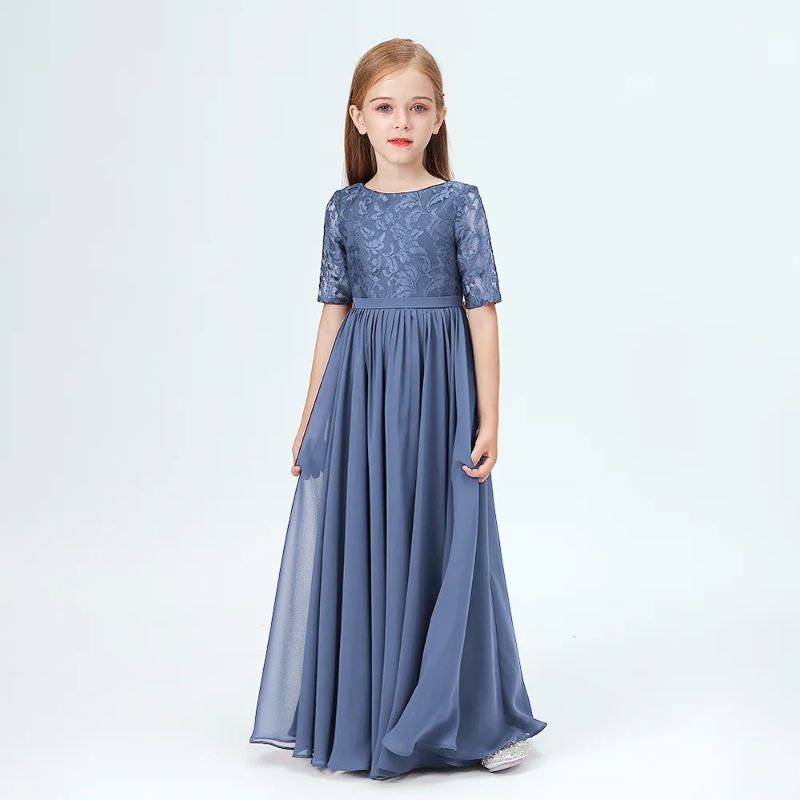
Wedding Dresses
Many modern wedding gowns use chiffon overlays over satin or lace underdresses. This creates texture and movement while maintaining modesty. The fabric works for both beach weddings (it’s light and breezy) and formal church ceremonies (it photographs elegantly).
Chiffon wedding dresses typically feature layered skirts, flowing sleeves, or delicate overlays. The fabric pairs beautifully with beading and embroidery, which shows through the sheer layers for added dimension.
Bridesmaid Dresses
Chiffon bridesmaid dresses have several advantages over other fabrics:
- The fabric flatters different body types because it skims rather than clings
- Available in countless colors for matching your wedding palette
- Comfortable to wear for long events
- Moves beautifully in photos
- More affordable than many other formal fabrics
- Can be reworn for other events
Popular styles include A-line silhouettes in floor length, off-shoulder designs with flowing sleeves, layered skirts for added dimension, and convertible styles with adjustable necklines.
Choosing colors? Emerald green, dusty rose, champagne, and terracotta continue to dominate bridesmaid dress trends. The sheer quality of chiffon lets you layer different shades for an ombre effect, creating visual interest for your bridal party.
Care and Maintenance
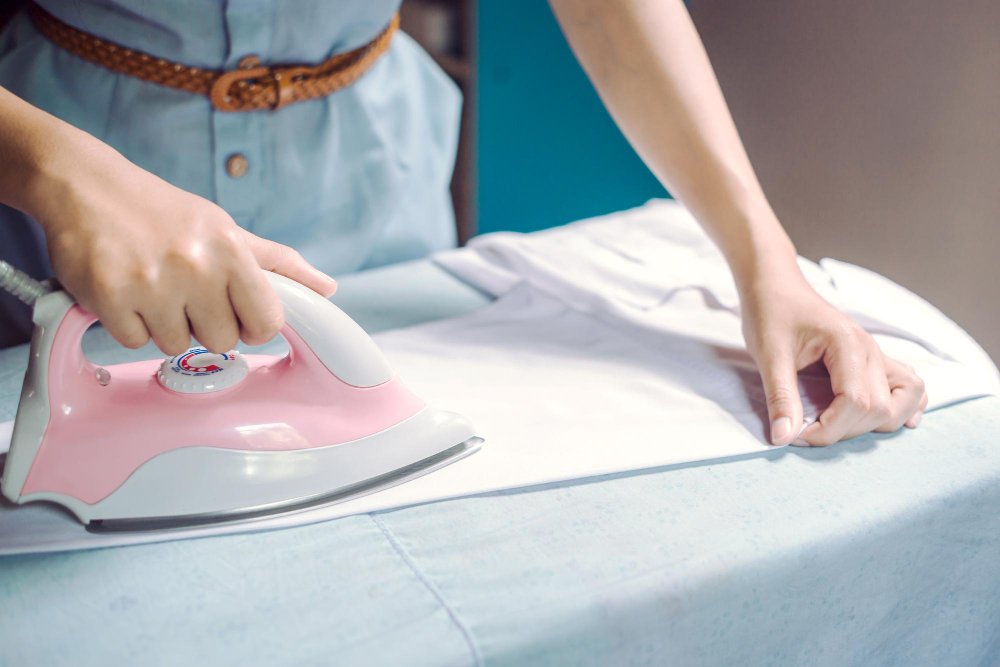
Proper care keeps your chiffon garments looking beautiful for years. The care method depends entirely on which type you have.
Can You Wash Chiffon?
It depends completely on the fiber content. Always check the care label first. Here’s what you need to know:
Silk Chiffon: Dry clean only. The delicate fibers can’t handle water and regular detergent without damage. Water can cause spotting, and agitation can damage the fibers permanently. If you absolutely must hand wash silk chiffon (not recommended), use cold water and special silk detergent, then lay flat to dry. Even then, dry cleaning is much safer.
Polyester Chiffon: Yes, you can wash this! Use cold water on your machine’s delicate cycle. Put the garment in a mesh laundry bag to protect it from snags. Use mild detergent and skip the fabric softener, which can leave residue on synthetic fabrics.
Cotton Chiffon: Machine washable in cold water on gentle cycle. It gets softer with each wash. You can even iron it on low heat with a pressing cloth.
Rayon Chiffon: Hand wash only. Rayon weakens significantly when wet, so treat it very gently. Use lukewarm water and mild soap, then lay flat to dry. Never wring or twist rayon chiffon.
For more details on washing different fabrics, see our fabric care guide.
How to Wash Chiffon?
For washable chiffon (polyester and cotton), follow these steps:
- Turn the garment inside out to protect the outer surface
- Place in a mesh laundry bag to prevent snags
- Use cold water and delicate cycle
- Add mild detergent (about half the normal amount)
- Skip the spin cycle or use the lowest setting
- Remove immediately when done
- Lay flat on a clean towel to air dry, away from direct sunlight
For silk chiffon, take it to a professional dry cleaner. For rayon, hand wash in a basin with lukewarm water, gently swish (don’t agitate), rinse carefully, and lay flat to dry.
Can Chiffon Go in Water?
It depends on the type. Polyester and cotton chiffon can safely go in water (cold, gentle washing). Silk chiffon should avoid water as it can damage the fibers and cause spotting that may be permanent. Rayon chiffon can be hand washed but becomes weak when wet, so handle it very carefully and support the weight of the wet fabric.
Can Chiffon Be Ironed?
Yes, but you need to be extremely careful. Use the lowest heat setting on your iron (usually marked “silk” or “synthetic”). Never place the iron directly on chiffon because you risk melting synthetic fibers or scorching natural ones. Always use a pressing cloth between the iron and fabric.
Better yet, use a steamer instead of an iron. Steamers are safer and work just as well. You can also hang your chiffon garment in a steamy bathroom for 10-15 minutes, and wrinkles often fall out on their own.
Can You Iron Chiffon?
Yes, you can iron chiffon if you follow the rules: lowest heat, pressing cloth, quick movements. Don’t let the iron sit in one spot, as this can melt synthetic fibers or create shiny marks on natural fibers. Test on a hidden area first. Many people find steaming easier and safer than ironing for chiffon.
Can Chiffon Be Put in the Dryer?
Never put chiffon in the dryer, regardless of fiber type. The heat can melt synthetic versions, shrink natural fibers, and cause excessive wrinkling. The tumbling will also potentially stretch the fabric or catch it on other items, causing tears. Always air dry chiffon garments.
How Do You Care for Chiffon?
Beyond washing, proper care includes:
- Address stains immediately by blotting (never rubbing) with a clean, damp cloth
- Store on padded hangers to prevent creases
- Keep away from direct sunlight, which fades colors
- Store in cool, dry places
- Use garment bags for long-term storage
- Keep jewelry away from chiffon to prevent snags
- Inspect garments after each wear for snags or pulls
- Repair small problems immediately before they get worse
How Do You Care for Chiffon Fabric?
The key to long-lasting chiffon is preventing damage rather than fixing it. Handle the fabric carefully, avoid rough surfaces, and store properly. Regular care is simpler than trying to repair damaged chiffon. For special garments, consider professional cleaning even if the label says washable, especially before long-term storage.
Storage Tips
Store chiffon garments on padded hangers to prevent creases at fold lines. Wire or plastic hangers can create permanent marks. If you must fold them, place acid-free tissue paper between the folds to prevent creases from setting.
Keep them in a cool, dry place away from direct sunlight, which fades colors over time. Consider breathable garment bags for long-term storage to protect from dust and snags. Never store chiffon in plastic bags, which trap moisture and can cause mildew.
Stain Removal
Address stains immediately for best results. Blot (never rub) with a clean, damp cloth. Rubbing spreads the stain and damages fibers. For stubborn stains on polyester or cotton chiffon, spot clean with mild detergent before washing the entire garment.
Silk chiffon stains require professional cleaning. Never try to remove stains from silk yourself, as you might make them permanent or damage the fabric. Take it to a cleaner as soon as possible and point out the stain location.
Sustainability Considerations
If you care about environmental impact, your choice of chiffon type makes a big difference. Not all chiffon is created equal when it comes to sustainability.
Environmental Impact of Common Chiffon Types
Polyester Chiffon: This has the biggest environmental footprint. It’s made from petroleum, a non-renewable resource. Production requires high energy use and releases greenhouse gases. The fabric doesn’t biodegrade and will sit in landfills for hundreds of years. Each wash releases microplastics into waterways, harming marine life. These microplastics enter the food chain and eventually end up in our bodies.
Silk Chiffon: Better environmentally than polyester, but not perfect. Silk is natural and biodegradable, breaking down within a few years. However, production uses significant water and energy. Some silk production also uses harmful chemicals in the dyeing process. The good news? You can find organic silk certified by GOTS (Global Organic Textile Standard), which eliminates harmful chemicals.
Cotton Chiffon: More sustainable than polyester but depends on farming methods. Conventional cotton uses heavy pesticides and huge amounts of water (about 2,700 liters for one t-shirt’s worth of cotton). Organic cotton eliminates pesticides but still requires substantial water. Still, cotton biodegrades and doesn’t release microplastics.
Eco-Friendly Alternatives
If sustainability is important to you, consider these options:
- Tencel/Lyocell Chiffon: Made from sustainably sourced wood pulp using a closed-loop process that recycles 99.5% of water and solvents. Biodegradable and soft.
- Recycled Polyester Chiffon: Made from plastic bottles, reducing waste. Still releases microplastics but diverts waste from landfills and uses less energy than virgin polyester.
- Organic Silk: Grown without harmful pesticides, often with better water management practices.
- Organic Cotton: No synthetic pesticides or harmful chemicals in production.
- Peace Silk (Ahimsa Silk): Harvested without killing silkworms, addressing ethical concerns about traditional silk production.
Read more about sustainable choices in our organic cotton guide and learn about plant-based polyester alternatives.
Certifications to Look For
These certifications help you identify truly sustainable chiffon:
- GOTS (Global Organic Textile Standard): Requires at least 95% organic fibers and strict environmental and social criteria
- GRS (Global Recycle Standard): Certifies recycled content in synthetic fabrics
- OEKO-TEX Standard 100: Ensures no harmful chemicals in the final product
- bluesign®: Covers the entire production chain for sustainability
- FSC (Forest Stewardship Council): For Tencel/Lyocell, certifies sustainable forest management
Making Sustainable Choices
Beyond choosing eco-friendly chiffon, you can reduce your environmental impact:
- Buy quality pieces that last years instead of cheap fast fashion
- Wash less frequently (spot clean when possible) and always use cold water
- Use a Guppyfriend bag when washing synthetic chiffon to catch microplastics before they reach waterways
- Repair damaged garments instead of replacing them
- Donate or recycle chiffon items you no longer wear
- Buy secondhand chiffon garments when possible
- Choose natural fibers when you can’t find recycled synthetics
Learn more about making eco-conscious choices in our fast fashion vs slow fashion guide.
Buying Guide and Prices
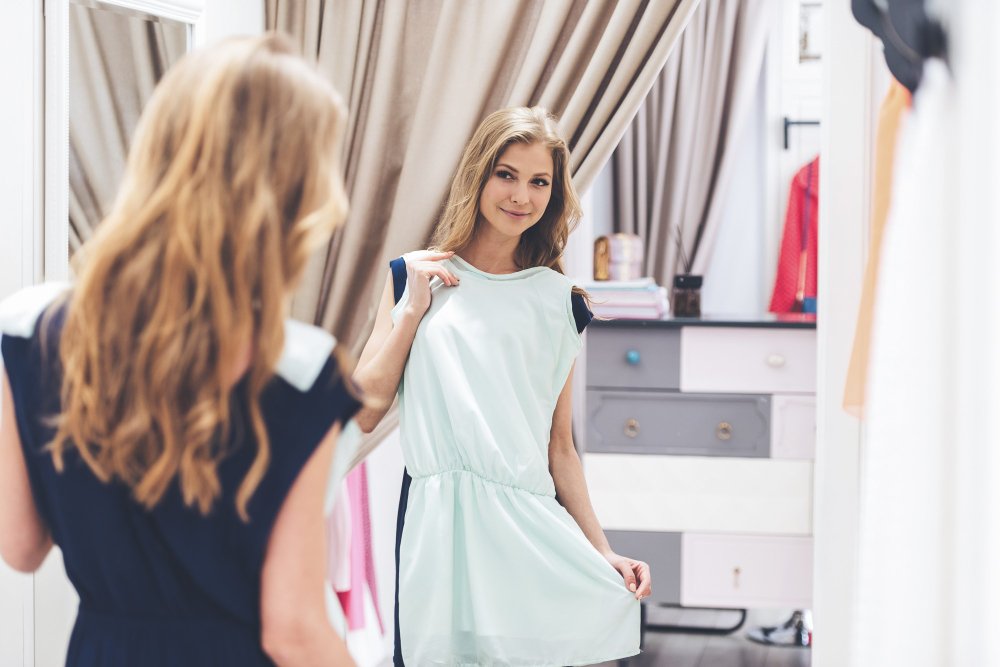
Shopping for chiffon can feel overwhelming with so many options and price points. Here’s what you need to know to make smart purchases.
Price Ranges by Type
| Type | Price Per Yard | Best For | Budget Level |
|---|---|---|---|
| Polyester Chiffon | $3-$12 | Practice, everyday wear, beginners | Budget-friendly |
| Rayon Chiffon | $8-$20 | Better drape on a budget | Mid-range |
| Cotton Chiffon | $10-$25 | Eco-conscious, washable, natural fiber | Mid-range |
| Silk Chiffon | $18-$45 | Special occasions, luxury garments | High-end |
| Specialty (Jacquard, Pearl) | $25-$60 | Unique designs, statement pieces | Premium |
Is Chiffon Expensive?
It varies widely by type. Polyester chiffon is quite affordable at $3-$12 per yard, making it accessible for most budgets and great for practice. Silk chiffon costs $18-$45 per yard, putting it in the luxury category alongside other high-end fabrics. Specialty chiffons like jacquard or pearl can reach $60 per yard. The wide price range means there’s chiffon for every budget.
Is Chiffon a Cheap Fabric?
Polyester chiffon is budget-friendly, but “cheap” doesn’t mean poor quality. The low cost comes from efficient manufacturing, not inferior construction. However, very cheap chiffon under $3/yard may feel plasticky and lack the drape of better quality options. Spend at least $5-$7 per yard for polyester chiffon that looks and feels good.
Is Pure Chiffon Expensive?
“Pure chiffon” usually means silk chiffon, and yes, it’s expensive at $18-$45 per yard. The high cost reflects the time-intensive silk production process and the quality of the material. If someone offers “pure silk chiffon” for under $10 per yard, it’s probably not real silk or it’s poor quality.
Is Chiffon an Expensive Fabric?
Compared to basic cotton or polyester, silk chiffon is expensive. But compared to other luxury fabrics like silk velvet or fine wool, silk chiffon falls in the mid-to-upper range. Polyester chiffon is actually one of the more affordable special occasion fabrics available, cheaper than most satins, taffetas, or brocades.
Is Chiffon a Luxury Fabric?
Silk chiffon is definitely a luxury fabric, prized by high-end designers for couture and bridal wear. Polyester chiffon isn’t considered luxury, though it can create beautiful garments. The perception of luxury depends on fiber content, construction quality, and how it’s used in the design. A well-made polyester chiffon dress can look more luxurious than a poorly designed silk one.
Quality Indicators
When shopping for chiffon, check these signs of quality regardless of price:
- Even Weave: Hold it up to light. The weave should look consistent without thick or thin spots or holes.
- Weight: Quality chiffon has some substance while remaining light. Very cheap polyester feels plasticky and stiff.
- Recovery Test: Scrunch it in your hand, then let go. Good chiffon bounces back without staying severely wrinkled.
- Color: Dye should be even throughout with no blotching, fading, or streaking.
- Hand Feel: It should feel pleasant, not scratchy, stiff, or slimy.
- Drape: Drape it over your hand. It should flow smoothly, not stand out stiffly.
Where to Buy Chiffon
You have several options for purchasing chiffon fabric:
Online Retailers:
- Mood Fabrics – Extensive selection, good quality, higher prices
- Fabric.com – Budget-friendly options, wide variety
- Fashion Fabrics Club – Discounted silk chiffon, sales
- OnlineFabricStore – Good for polyester chiffon, reasonable prices
Local Fabric Stores: Shopping in person lets you feel the fabric before buying. This is especially important for first-time chiffon buyers who need to understand the texture and drape. Many stores also offer bulk discounts if you’re buying large quantities.
Wholesale Suppliers: If you’re making multiple garments or designing professionally, wholesale can save 30-50% on costs. Minimum orders typically start at 25-50 yards. This works well for bridesmaids dresses or starting a small business.
How Much Fabric Do You Need?
Chiffon is typically 42-60 inches wide. For common projects, you’ll need:
- Short dress (above knee): 2-3 yards
- Maxi dress (floor length): 4-6 yards
- Simple blouse: 2-2.5 yards
- Full skirt: 2-3 yards
- Scarf (standard size): 1-1.5 yards
- Layered evening gown: 8-12 yards (multiple layers)
Always buy 10-20% extra for mistakes, pattern matching, shrinkage (if prewashing), or future repairs. With chiffon’s slippery nature, having extra is better than running short mid-project.
Project Ideas by Skill Level
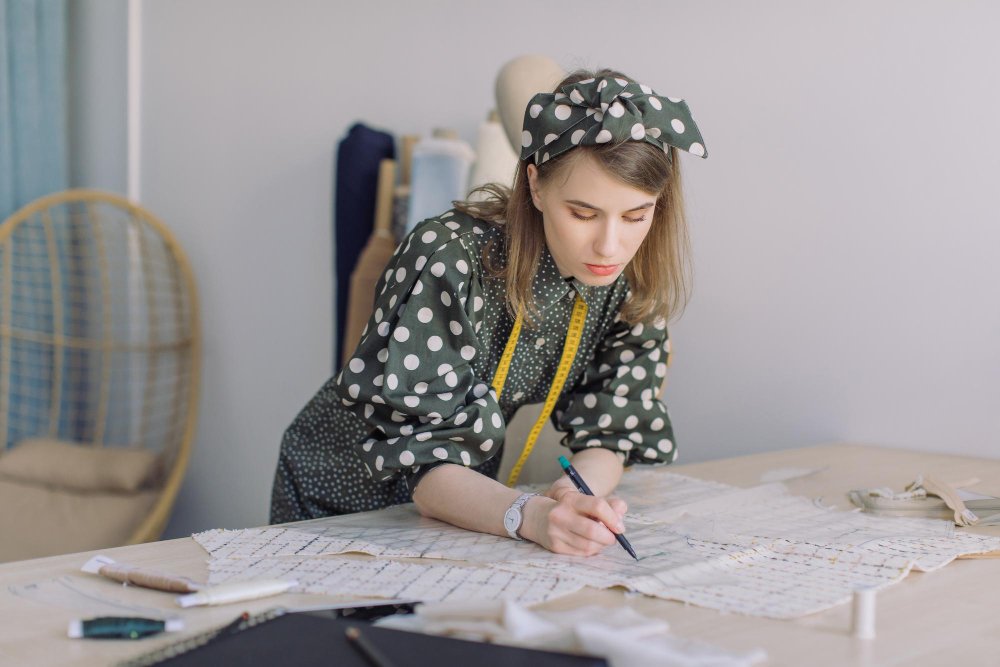
Ready to start working with chiffon? Here are projects matched to your experience level.
Beginner Projects
If you’re new to chiffon, start small and simple. These projects let you practice techniques without a huge time investment:
- Simple Scarf: Just hem the edges. This is perfect for practicing your rolled hem technique without stress. Use 1-1.5 yards of polyester chiffon.
- Pillowcase Overlay: Add a chiffon layer over a solid pillow for texture. Straight seams and simple construction.
- Table Runner: Straight seams and simple hems teach you fabric handling without complex fitting.
- Hair Scrunchie: Small project that lets you practice gathering and working with the slippery fabric.
- Infinity Scarf: One seam and hemming. Simple but useful.
Find more beginner-friendly ideas in our easy sewing projects guide.
Intermediate Projects
Once you’re comfortable with basic techniques and have made a simple project successfully:
- Layered Skirt: Practice working with multiple layers and learning how they move together. Use an elastic waist for easier construction.
- Simple Blouse: Use a basic pattern with minimal fitting. Add a lining for opacity and practice setting in sleeves.
- Kimono Robe: Straight pieces with beautiful drape. No difficult fitting required. Great for showcasing chiffon’s flow.
- Maxi Dress: Simple silhouette with flowing skirt. Practice French seams on a real garment.
- Window Scarves: Decorative home decor that requires precise measuring but straightforward construction.
Advanced Projects
Ready for a challenge? These projects require all your chiffon skills:
- Evening Gown: Multiple layers, fitted bodice, and flowing skirt test all your skills. Often combines chiffon with other fabrics.
- Wedding Dress: The ultimate chiffon project combining structure, flow, and detailed finishing. Not for the faint of heart.
- Pleated Garments: Creating and maintaining permanent pleats in chiffon requires patience and precision.
- Bias-Cut Dress: Working with chiffon on the bias requires advanced understanding of grain and stretch.
- Fully Lined Coat: Chiffon lining in a coat requires careful construction and finishing.
Before starting any project, read our guide on reading sewing patterns and check our beginner-friendly patterns.
Common Problems and Solutions
What Are the Disadvantages of Chiffon Fabric?
While chiffon is beautiful, it has some downsides you should know about:
- Difficult to Sew: The slippery, delicate nature makes it challenging, especially for beginners
- Frays Easily: Raw edges unravel quickly, requiring special seam finishes
- Snags Easily: Jewelry, rough surfaces, and fingernails can catch and pull threads
- Transparency: Usually requires lining or layering, adding cost and construction time
- Care Requirements: Silk chiffon needs dry cleaning; even washable types need special care
- Shows Imperfections: The sheer nature means construction mistakes are visible
- Not Durable for Daily Wear: Better for special occasions than everyday rough use
What Are the Disadvantages of Chiffon?
Additional disadvantages include the fabric’s tendency to shift during cutting and sewing, making precise work difficult. It’s also not suitable for structured garments that need to hold a specific shape. The lightweight nature means it can blow around in wind, which may be impractical for some situations.
Myth Busting
Let’s clear up common misconceptions about chiffon:
Myth: “Chiffon is impossible to sew.”
Truth: It’s challenging but totally manageable with proper techniques, patience, and the right tools. Thousands of people successfully sew chiffon every day.
Myth: “All chiffon is the same.”
Truth: Huge differences exist between silk, polyester, cotton, and rayon versions in feel, care, price, and performance.
Myth: “Chiffon must be dry cleaned.”
Truth: Only silk chiffon requires dry cleaning. Polyester and cotton can be machine washed at home carefully.
Myth: “Expensive chiffon is always better.”
Truth: For many projects, polyester chiffon works better than silk due to its durability, easy care, and wrinkle resistance. “Better” depends on your needs.
Myth: “You need a special machine to sew chiffon.”
Truth: Any regular sewing machine works fine with the right needle, settings, and techniques.
What Is the Most Difficult Fabric to Sew?
While chiffon is challenging, it’s not the hardest. Velvet, leather, very stretchy knits, and fur are generally considered more difficult. Chiffon’s main challenge is preventing slipping and fraying, which you can overcome with proper stabilizers and techniques. Each difficult fabric has its own unique challenges.
Is Chiffon a Nice Fabric?
Yes! Despite its challenges, chiffon is considered a beautiful, elegant fabric. It drapes wonderfully, feels pleasant against skin (especially silk and rayon types), and creates stunning flowing garments. The romantic, ethereal quality makes it perfect for special occasions. While it requires more care than sturdy cottons, many people find the results worth the effort. Whether chiffon is “nice” depends on what you’re using it for and your willingness to handle it carefully.
Frequently Asked Questions
Conclusion
Chiffon is one of fashion’s most beautiful and versatile fabrics. From its origins in 18th-century French nobility to today’s accessible polyester versions, chiffon has maintained its reputation for creating stunning, flowing garments that photograph beautifully and feel wonderful to wear.
Whether you choose budget-friendly polyester at $3-$12 per yard or luxurious silk at $18-$45 per yard, understanding the different types helps you pick the right chiffon for your needs. Polyester works perfectly for practice projects and everyday wear. Silk shines for special occasions when you want ultimate luxury. Cotton offers eco-friendly breathability. Each type has its place.
Yes, chiffon presents challenges. It slips during cutting, frays quickly, and requires careful handling. But these challenges become manageable once you learn the right techniques. Use Microtex sharp needles, sew slowly with tissue paper stabilizer, and finish seams with French seams or careful binding. Practice on scrap fabric first, and don’t rush.
The effort pays off in garments that flow beautifully, photograph elegantly, and feel comfortable to wear. From summer blouses that keep you cool to evening gowns that make you feel like you’re floating, chiffon creates magic that few other fabrics can match.
Key Takeaways
- Know your fiber types: Polyester is affordable and practical; silk is luxurious but requires dry cleaning; cotton is eco-friendly and washable
- Use the right tools: Microtex needles (60/8 or 70/10), tissue paper, fabric weights, and fine thread make all the difference
- Master essential techniques: French seams, rolled hems, and stabilizer prevent common problems
- Care properly: Follow fiber-specific washing instructions; always air dry; use low heat for ironing with a pressing cloth
- Consider sustainability: Look for organic, recycled, or Tencel options if environmental impact matters to you
- Start simple: Begin with small projects like scarves before attempting complex garments
- Buy quality: Spend at least $5-$7/yard for polyester chiffon that looks and feels good
- Practice patience: Chiffon rewards slow, careful work; rushing leads to mistakes
Final Recommendations
If you’re new to chiffon, start with polyester. It’s forgiving, affordable, and lets you practice without fear of ruining expensive fabric. Make a simple scarf or pillowcase overlay first. Once you’re comfortable, move to a simple blouse or skirt.
For special occasion sewing, invest in quality fabric. The difference between $3 and $7 polyester chiffon is noticeable in drape and appearance. For heirloom projects like wedding dresses, silk chiffon justifies its price.
Remember that chiffon isn’t suitable for everything. It works beautifully for flowing, romantic designs but poorly for structured, tailored garments. Choose chiffon when you want movement, elegance, and that ethereal quality that makes garments look like they’re floating.
Don’t be discouraged if your first chiffon project isn’t perfect. Every experienced sewer struggled with chiffon initially. The learning curve is real, but so are the rewards. Your second project will be better than your first, and your third better than your second.
Take advantage of the resources available to you. Check out our beginner’s guide to sewing if you’re new to sewing in general. Use our interactive tools to help plan your projects and calculate fabric needs. Join online sewing communities where you can ask questions and share your progress.
Most importantly, have fun with it. Yes, chiffon can be challenging, but creating something beautiful with your own hands is incredibly rewarding. Whether you’re making a simple scarf or an elaborate gown, you’re working with a fabric that has dressed royalty and red carpets for centuries. That’s something special.
Now that you understand chiffon from fiber types to sewing techniques to care instructions, you’re ready to start your own chiffon journey. Pick a simple project, buy some fabric, and give it a try. You might be surprised at what you can create.
For more sewing guidance and fabric information, explore our other articles on fabric types, sewing techniques, and fashion trends. Happy sewing!
Additional Resources
For more detailed information about chiffon and related topics, check these authoritative sources:

